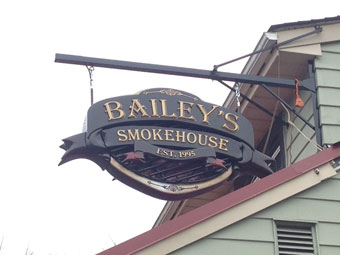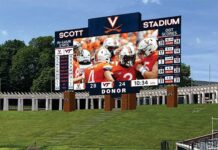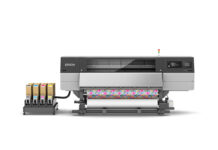“We love a challenge,” states Stephen Hoey, an “Old World craftsman with Twenty-First Century tools” and president of KDF Custom Graphics in Rockleigh, New Jersey. “Usually our challenges come in the form of a tight schedule, a difficult design, or a slew of creative ideas that need to be quickly conceptualized, sifted through, and executed on.”
However KDF not only had to solve all these aforementioned challenges on a recent project, but they also had to deliver an extremely detailed custom dimensional sign featuring layers of HDU, steel tubing, and LED modules.
And they had eight days to build and install it for a restaurant in time to greet patrons on St. Patrick’s Day. “So we were going to earn our pint of Guinness on this one!” says Hoey.
First Course: Getting Started
A year ago, KDF had successfully designed, printed, and wrapped vinyl graphics onto a Bailey’s Smokehouse van. Because of this, the restaurant owners told Hoey they’d keep his company in mind for any future projects.
Bailey’s Smokehouse in Blauvelt, New York has earned a reputation as one of the best BBQ places in the area, and its owners are always on the lookout to make their restaurant even better. But one thing causing them fits was an old light box hanging over the restaurant’s original front door. “It didn’t look good any more, nor was it functioning properly,” explains Hoey, “so they removed it.”
However this left the owners with an empty space. So a year after the van wrap, they tapped KDF with a bigger request—a complete logo redesign and brand-new custom sign!
KDF is far from your traditional sign shop. Their well-rounded employees are always pushing their creative limits when it comes to large and wide format graphics, flatbed printing, wraps, dimensional signage, and custom fabrications in the New York, New Jersey, and Connecticut areas.
Hoey told the owners upfront that they could do either inexpensive, reverse-printed graphics to cover the empty light box space or create something that would “blow everyone’s minds.”
Fortunately for all involved, the owners eagerly opted for the latter.
(Note: Bailey’s Smokehouse gave KDF carte blanche in the sign and logo design.)
Here Hoey promised them the “best sign that anyone had ever seen” but admits he gave them what he considered a decent estimate without really knowing how his shop was going to build it. “We always go in promising a lot, however we want to make sure that we’re going to hit it out of the park and give them even more than what we promise,” says Hoey.
Second Course: Designing the Logo
KDF’s idea was to redesign the Bailey’s Smokehouse logo first and then use it as springboard for building the “best anyone has ever seen” sign.
There was a lot of back-and-forth over the course of three to four days during the logo design stages, trying to figure out the textures and feel. The restaurant owners wanted a logo that was traditional but high end. But the design team wanted to include elements that would appear cool in a finished sign.
“We incorporated everything that was important to the client—the fonts, the colors, the overall theme etc.—and then kicked it up a notch,” Hoey states, noting that they successfully convinced the owners to add items like filigrees to the finished logo.
Most of the new logo is an original KDF design. The only thing kept from the original logo was the font. “Since it had that desired high-end look, everyone agreed to keep it,” says Hoey.
Because there were so many elements, the KDF graphics department created the logo and signage ideas in a vector format using Adobe® Illustrator®.
Third Course: Constructing the Sign
With the logo design finalized and approved, it was time to build the sign from it.
The finished double-sided Bailey’s Smokehouse sign resembles a grill (all KDF’s idea). It measures forty-two inches high-by-seventy-six inches wide and is about sixteen inches deep. (Note: Originally the sign was supposed to have been even bigger, but city officials didn’t approve it.)
{2j_imageviewer 69}
The large “Bailey’s” letters were cut out of one-inch-thick fifteen-pound Precision Board HDU. In fact, most of the sign was made from fifteen- and thirty-pound Precision Board HDU. The only things that weren’t are the smaller “Smokehouse” letters (1/2-inch black PVC) and the grill portion (steel tubing).
Hoey is adamant not letting budget dictate the need for cheaper substrates. In fact, they always consider the best materials in the initial estimate. “We want these signs to last,” he says.
At the start of production, two teams were designated for this project: (A.) Hoey and Production Coordinator Mark Pilcher would design the sign parts in EnRoute Pro and cut them on the MultiCam 3000 CNC router, and (B.) Business Development Manager Brian Hamilton and Shop Manager Greg Gardula would fabricate and paint the sign pieces.
The first layer of the sign was cut out of two-inch-thick fifteen-pound Precision Board on the MultiCam 3000 CNC router. KDF created a middle layer of HDU and cut a pocket into it out of a steel hanger.
On the MultiCam 3000, KDF used a 1/8-inch ball end mill around the top and bottom of the filigree areas. On larger pieces, KDF started with a half-inch end mill and then took off all the material on the rough pass. Depending on how much detail was needed, they next came in with a smaller ball end mill and added texture to them.
Hoey worked out the depth of the overall sign and programmed the basic shape of the face and ribbon with the text in EnRoute Pro. After cutting, he sent the carved HDU to Hamilton for some hand sculpting to remove the “machine cut” look.
In addition to detailing the ribbons and face of the sign, Hoey extruded the accent lines on the font. “Then I cut a pocket into the ribbon to easily register the letters, which I cut separately,” he explains.
KDF 3D-cut the face of the ribbons and left the accent lines of the font on the ribbon. “This way, it would create a dramatic depth when placing the letters,” says Hoey.
The letters are mounted to the sign via custom stand-offs that Hamilton fabricated himself.
Fourth Course: The Grill
The grill section of the sign was built in layers from scratch. Hamilton made these grills out of one-inch steel tubing. “Even though you can’t see 60 percent of it, the grill is full-size,” reaffirms Hoey.
The steel tubes were eventually glued into the frame. Hamilton welded a set of posts all around the back of it. “Because of this, it had a really nice seat,” says Hoey. “We had to put this together and take it apart multiple times for fitting purposes and things like that.”
After bending the outside tubing around the form, Hamilton welded it.
Look closely and you’ll notice glowing charcoal pieces underneath the grill tubes. KDF created these 3-D carvings on their MultiCam 3000. Hamilton then went in with a die-grinder (“a wonderful tool”) to give them a lot more definition.
KDF placed red and yellow LEDs on the inside contour of the frame below the grill, as well as along the bottom of the sign interior. “The LEDs are tucked up underneath, following around the curve of the bottom and coming up underneath the ‘Bailey’s’ on top,” explains Hoey. “It casts light perfectly over those faux-coals.”
They placed the LEDs in this fashion because people walking underneath the sign were going to be able to look up and see right through it. “We wanted it to feel like you were looking into a real grill,” says Hoey.
{2j_imageviewer 70}
Fifth Course: The Painting
The sign was disassembled and reassembled plenty of times during sculpting, in order to make sure everything fit the way it was supposed. Hamilton sanded a lot of the sign and then registered all the parts and pinned them. Then he disassembled everything again, so he could apply priming.
The entire sign was painted using Matthews Paint Systems, as well as with a gloss overcoat. KDF had to finish all the pieces separately. “There’s so much depth when you look at this,” remarks Hoey. “Everything had to be painted separately and then put together for clear-coating.”
(Note: Hamilton also touched up the “warmed up” area on the left and right sides of the bottom ribbon, by experimenting with warm airbrush colors.)
Painting was achieved multiple ways. The small pieces were all painted on tables. “Once assembly started, we hung the pieces from a piece of steel attached the ceiling, so we could paint both sides,” he says.
Hoey usually pockets out where all the text is going to go on a sign, then paints everything and inserts the letters afterwards. But because of the font type being used, this wasn’t going to be easy to do. “So we pocketed out where part of the font was and then cut a thin line onto the face of the Precision Board that follows the rest of the font,” he explains.
Hamilton painted all the grills and welded them onto the framework. He also hand-painted the gold details and the filigree.
Sixth Course: Installing the Sign
After painting, the PVC letters were stud-mounted to the HDU. Everything else (the front face pieces and the grill) was either glued or screwed to the sign.
The finished sign weighs 200 pounds and was rolled out the garage doors to where KDF’s bucket truck picked it up and placed it on its bed for transportation.
It currently hangs approximately twenty feet off the ground on a giant L bracket over the original front entrance of the restaurant. The three-inch steel L brackets were attached to the building via a bucket truck a few days before the install. That way, KDF would only have to focus on delivering and installing the finished sign on the Sunday before St. Patrick’s Day (on a Monday this year).
The power supply for the LEDs is mounted inside the L bracket frame, and an electrician ran the power from it to the source from their old light box.
Before the install, KDF took some final measurements to be on the safe side. They then rope-tied the sign to the bucket truck and lifted it up. “I was on the ground with a guide rope, Installer John Friscia worked the bucket, and [Hamilton] was on the roof guiding the sign into place” says Hoey.
KDF had to make sure they set up their bucket truck in a location where they could not only pick up the 200-pound sign but also be able to level it right at the L bracket. “Because there’s a curve on the top of the sign, we had our threaded rod coming up just a little bit above the top of that curve,” explains Hoey. “We needed to make sure we were literally right at the connecting points.”
Installation lasted about five hours. “They were really busy that day, which was kind of cool,” remarks Hoey, “because a lot of people out there were passing by and commenting on how amazing the new sign looked.”
In the end, installation went smoothly. “There’s a wire harness on the building as well, which helped,” says Hoey, noting with a smile that working only feet away from Guinness and smoked BBQ caused its own personal challenge.

Seventh Course: After-Dinner Talk
Bailey’s Smokehouse is located in an older house, and the owners have slowly been trying to update its appearance. “Now that they’ve got this nice, new sign with its ribbons and filigrees, they’re pushing to make the exterior redo happen a little bit quicker,” says Hoey.
Hoey believes that working with clients open to doing something different are the best kind of customers. “This allowed us the opportunity to come up with the coolest sign to design and build for them,” he states. “We were able to keep the traditional look they wanted but also add creative touches (like the glowing grill) to it.”
The client’s reaction was priceless. “They’d never seen anything like it before,” boasts Hoey. “They thought it was going to be something traditional or even v-bit carved. They had no idea!”
And for KDF, they were just as excited constructing something super-fun. “While building this sign,” says Hoey, “we just loved knowing that it was going to blow the owners away when they saw it.
“We couldn’t have been happier!”
By Jeff Wooten
All photos: KDF Custom Graphics.











